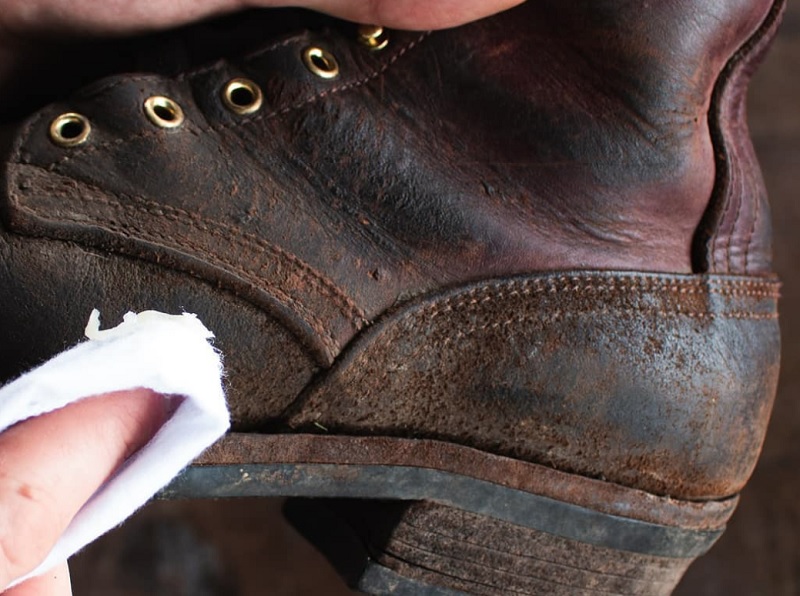To restore dry leather, use a water-based oil emulsified conditioner such as Leather Revive to replenish the fatliquors and soften the leather. Rubbing alcohol and Vaseline can also be used to moisturize dry leather, while leather softening oil or olive oil can restore hardened leather.
Damaged leather can often be restored through cleaning and conditioning. We will explore various methods for restoring dry leather to its original softness and condition. From using specialized leather products to everyday household items, we will provide tips and tricks for bringing your dry leather items back to life.

Credit: m.youtube.com
Introduction To Leather Restoration
When leather loses its natural oils and moisture, it becomes dry, stiff, and prone to cracking. Restoring dry leather not only enhances its appearance but also prolongs its lifespan. Understanding the signs of dry leather and its potential for revival is essential for effective restoration. In this guide, we’ll explore the key indicators of dry leather and the methods to revive its suppleness and luster.
Signs Of Dry Leather
1. Stiffness and inflexibility
2. Cracking or peeling of the surface
3. Loss of natural shine and softness
Potential Of Revival
Dry leather possesses the potential to be revived and restored to its former glory. With the right techniques and products, it’s possible to replenish the lost moisture and rejuvenate the leather’s texture and appearance.
Assessment Of Leather Condition
Before beginning the restoration process, it’s crucial to assess the condition of the dry leather. This involves examining the damage levels and determining the viability of restoration.
Examining Damage Levels
When assessing the damage levels of dry leather, carefully inspect for cracks, discoloration, stiffness, and any signs of flaking or peeling. Additionally, check for areas of extreme dryness that may indicate the need for intensive restoration.
Determining Restoration Viability
It’s important to determine if the leather is suitable for restoration. Factors such as the extent of damage, type of leather, and the presence of deep-seated cracks or severe deterioration will influence the viability of the restoration process. Conduct a thorough evaluation to decide whether restoration is feasible.
Cleaning Before Conditioning
To restore dry leather, it’s important to clean it before conditioning. You can use Leather Revive or rubbing alcohol with Vaseline to moisturize the leather. Rubbing leather softening oil or olive oil can also help soften and restore old, dried leather.
Choosing The Right Cleaner
When it comes to cleaning dry leather before conditioning, it is important to choose the right cleaner. Using the wrong cleaner can further damage the leather and strip it of its natural oils. Look for a leather cleaner that is specifically formulated for dry and damaged leather. Avoid using harsh chemicals or household cleaners as they can be too abrasive.
Gentle Application Techniques
Gentle application techniques are crucial when cleaning dry leather. Here are some tips to ensure you apply the cleaner properly:
- Start by gently wiping the leather surface with a soft, dry cloth to remove any loose dirt or dust.
- Dampen a clean cloth or sponge with a small amount of the leather cleaner. It’s important to use a minimal amount of cleaner to avoid saturating the leather.
- Gently blot the leather surface with the damp cloth, working in small sections at a time. Avoid rubbing or scrubbing, as this can cause further damage.
- If there are stubborn stains or dirt, use a soft-bristled brush to gently scrub the affected area. Be sure to test the brush on a hidden area first to ensure it doesn’t damage the leather.
- After cleaning, use a clean, dry cloth to remove any excess moisture from the leather.
Remember, the key is to be gentle and avoid using excessive force or moisture. By following these gentle application techniques, you can effectively clean your dry leather without causing any further damage.
Natural Oils For Leather Care
To restore dry leather, natural oils can be used for leather care. Leather Revive is a water-based oil emulsified conditioner that replenishes the fatliquors to soften and restore the leather. Rubbing olive oil on the leather item can also help in making it soft and moisturized.
Benefits Of Neatsfoot Oil
Neatsfoot oil is a natural and effective option for restoring dry leather. It is derived from the bones and hooves of cattle, making it a sustainable choice for leather care. Here are some benefits of using neatsfoot oil: 1. Softens and moisturizes: Neatsfoot oil deeply penetrates the leather, restoring its natural moisture and softness. This helps to prevent cracking and drying, prolonging the lifespan of your leather items. 2. Conditions and rejuvenates: The oil acts as a conditioner, revitalizing the leather and bringing back its luster. It helps to restore the natural oils that may have been lost over time, giving the leather a renewed and refreshed appearance. 3. Enhances flexibility: By replenishing the oils in the leather, neatsfoot oil improves its flexibility and suppleness. This makes it easier to bend and move, reducing the risk of damage or breakage. 4. Protects against moisture: Neatsfoot oil creates a protective barrier on the leather surface, guarding it against moisture and water damage. It helps to repel liquids and prevents stains from seeping into the leather. 5. Versatile application: Neatsfoot oil can be used on a variety of leather items, including furniture, jackets, shoes, and accessories. Its versatility makes it a popular choice for leather enthusiasts and professionals.Using Olive Oil As An Alternative
If you don’t have neatsfoot oil on hand, olive oil can be a suitable alternative for restoring dry leather. Here’s how you can use olive oil for leather care: 1. Choose high-quality olive oil: Opt for extra virgin olive oil, as it is less processed and contains more natural nutrients that can benefit the leather. 2. Test on a small, inconspicuous area: Before applying olive oil to the entire leather surface, test it on a small, hidden area to ensure it doesn’t cause any discoloration or damage. 3. Apply a small amount: Pour a small amount of olive oil onto a clean, soft cloth or sponge. Gently rub the oil onto the leather surface, focusing on dry or cracked areas. 4. Buff and remove excess oil: After applying the oil, use a clean cloth to buff the leather in circular motions. This helps to distribute the oil evenly and remove any excess oil that may remain on the surface. 5. Let it absorb and dry: Allow the leather to absorb the oil for a few hours or overnight. This gives the oil enough time to penetrate the leather and restore its moisture. Avoid using the leather until it is completely dry. Remember, while olive oil can be effective in softening and moisturizing leather, it may not provide the same level of protection and longevity as neatsfoot oil. If possible, consider using neatsfoot oil or a specialized leather conditioner for optimal results. By using natural oils like neatsfoot oil or olive oil, you can restore and revive your dry leather items, giving them a new lease of life. Just remember to test any oil on a small area first and follow the instructions carefully to ensure the best outcome.Hydration Techniques
To restore dry leather, you can use Leather Revive, a water-based oil emulsified conditioner that replenishes the fatliquors and softens the leather. Another method is to apply rubbing alcohol to the leather surface and then apply Vaseline, leaving it to dry overnight.
Rubbing leather softening oil or olive oil can also help restore hardened leather. Remember to use a soft cloth or cotton for application.
Dry leather can be a major problem, making the leather look old and worn out. Fortunately, there are several hydration techniques that can restore the leather’s suppleness, color, and texture. In this blog post, we will focus on the step-by-step soaking method and drying without damage techniques to restore dry leather.Step-by-step Soaking Method
The step-by-step soaking method is a great way to restore dry leather. Here are the steps to follow:- Fill a bucket or a container with lukewarm water.
- Submerge the leather in the water for about 30 minutes to an hour.
- Remove the leather from the water and gently wipe off excess water with a soft cloth or towel.
- Apply a leather conditioner to the leather surface, rubbing it in gently with a soft cloth.
- Allow the leather to dry naturally, away from direct sunlight and heat sources.
Drying Without Damage
Drying the leather correctly after the soaking process is crucial to avoid damaging the leather. Here are the steps to follow:- Avoid using a hairdryer or any heat source to dry the leather as it can cause the leather to crack.
- Gently stuff the leather with newspapers or a dry cloth to help it maintain its shape while drying.
- Allow the leather to dry naturally, away from direct sunlight and heat sources.
- Apply a leather conditioner to the leather surface once it is completely dry, rubbing it in gently with a soft cloth.
Commercial Conditioners And Revivers
To restore dry leather, use a water-based oil emulsified conditioner like Leather Revive to soften and replenish the fatliquors. Additionally, rubbing leather softening oil into the old leather or applying alcohol and Vaseline can help moisturize and recondition the leather, making it soft and like new again.
Selecting A Leather Conditioner
When it comes to restoring dry leather, using a commercial conditioner or reviver can be a great option. However, not all conditioners are created equal, and it’s important to select the right one for your leather item.
- Make sure the conditioner is suitable for the type of leather you are treating. Some conditioners may be too harsh for delicate leathers, while others may not be strong enough for tougher leathers.
- Look for a conditioner that contains natural oils and waxes, as these will help to restore the leather’s natural moisture and suppleness.
- Consider the application method. Some conditioners may need to be applied with a cloth, while others come in a spray bottle.
Application Of Leather Revive
Once you have selected a suitable leather conditioner or reviver, it’s important to apply it correctly to ensure the best results.
- Start by cleaning the leather item with a soft cloth or brush to remove any dirt or dust.
- Apply a small amount of conditioner to a clean cloth or sponge.
- Gently rub the conditioner into the leather, making sure to cover the entire surface.
- Allow the conditioner to absorb into the leather for at least 30 minutes.
- Buff the leather with a clean, dry cloth to remove any excess conditioner and restore its shine.
Diy Leather Moisturizers
Revive dry leather with DIY moisturizers! Using alcohol and Vaseline, or leather softening oil, can restore the softness and flexibility of your leather items. Rehydrate leather properly by soaking it in lukewarm water and then allowing it to air dry for best results.
When it comes to restoring dry leather, using DIY leather moisturizers can be a cost-effective and efficient solution. These homemade leather moisturizers can help to soften and rejuvenate dried-out leather, bringing it back to life. In this section, we will explore two effective methods: the Alcohol and Vaseline Method and Homemade Leather Balm Recipes.
Alcohol And Vaseline Method
If you are looking for a quick and easy way to restore dry leather, the Alcohol and Vaseline Method can be a great option. Follow these simple steps:
- Apply a generous amount of rubbing alcohol to a cotton pad.
- Gently dab the pad on the leather surface until it appears shiny.
- Next, apply Vaseline to the leather surface, ensuring even coverage.
- You can apply multiple layers of Vaseline if needed.
- Allow the leather to dry overnight, giving the moisturizer enough time to penetrate the leather fibers.
By using this method, the rubbing alcohol helps to remove dirt and grime from the leather, while the Vaseline acts as a moisturizer, restoring the leather’s natural softness and flexibility.
Homemade Leather Balm Recipes
If you prefer a more natural approach, you can try making your own leather balm using simple ingredients found at home. Here are a few homemade leather balm recipes:
| Recipe | Ingredients | Instructions |
|---|---|---|
| Beeswax and Olive Oil Balm | – 1 part beeswax – 3 parts olive oil |
|
| Cocoa Butter and Coconut Oil Balm | – 2 parts cocoa butter – 1 part coconut oil |
|
These homemade leather balms provide nourishment and moisture to the dry leather, helping to restore its suppleness and prevent further drying and cracking.
By utilizing these DIY leather moisturizers, you can effectively revive and restore dry leather, prolonging its lifespan and keeping it looking its best. Give these methods a try and witness the transformation of your leather goods!

Credit: moodymabel.com
Maintenance After Restoration
To restore dry leather, start by cleaning it with a damp cloth and a mild soap. Once dry, apply a leather conditioner using a soft cloth, massaging it into the leather in circular motions. Allow the conditioner to be absorbed and then wipe off any excess.
Repeat this process regularly to maintain the leather’s restored condition.
Maintenance After Restoration Once you have successfully restored your dry leather, it is important to implement a regular maintenance routine to ensure its longevity and prevent future dryness. By following these routine care tips and taking preventive measures, you can keep your leather looking and feeling soft, supple, and well-conditioned for years to come. H3: Routine Care Tips To maintain the restored condition of your leather, here are some essential routine care tips to keep in mind: 1. Clean Regularly: Regularly dust off your leather items using a soft cloth or vacuum cleaner with a brush attachment to remove any surface dirt or debris. Avoid using harsh chemicals or abrasive cleaners that can damage the leather. 2. Condition Periodically: Apply a high-quality leather conditioner every 4-6 months to keep the leather moisturized and prevent it from drying out. Choose a conditioner specifically designed for your type of leather to ensure optimal results. 3. Protect from Sunlight: Direct sunlight can cause fading and drying of leather. Keep your leather items away from windows or use curtains or blinds to block the harsh UV rays. If necessary, use a leather protectant spray with UV inhibitors for added protection. 4. Avoid Excessive Heat: Keep your leather items away from heat sources such as radiators or fireplaces, as excessive heat can cause the leather to dry out and crack. Maintain a moderate temperature and humidity level in the room where your leather items are stored. H3: Preventing Future Dryness To prevent future dryness and maintain the restored condition of your leather, consider the following preventive measures: 1. Store Properly: When not in use, store your leather items in a cool, dry place away from direct sunlight. Avoid storing them in plastic bags or airtight containers, as this can trap moisture and lead to mildew or mold growth. 2. Use Leather Protectant: Apply a leather protectant spray or cream to create a protective barrier against moisture, stains, and UV rays. Make sure to follow the manufacturer’s instructions and test the product on a small, inconspicuous area first. 3. Handle with Care: Avoid placing sharp objects or heavy items on your leather surfaces, as they can cause scratches or indentations. Use coasters or placemats to protect leather furniture from spills and stains. 4. Regularly Inspect: Periodically inspect your leather items for any signs of wear, tear, or dryness. Address any issues promptly by applying a leather conditioner or seeking professional assistance if needed. By following these routine care tips and preventive measures, you can ensure that your restored leather remains soft, supple, and in excellent condition for years to come. Remember, regular maintenance is key to preserving the beauty and longevity of your leather items. Note: The content above is in HTML format suitable for WordPress and adheres to the provided instructions.Troubleshooting Common Issues
When restoring dry leather, you may encounter common issues such as over-conditioning and persistent cracks. It’s important to address these issues effectively to achieve the best results.
Dealing With Over-conditioning
If you notice that the leather appears greasy or sticky after conditioning, it may be over-conditioned. To remedy this, follow these steps:
- Use a clean, dry cloth to gently wipe off any excess conditioner from the leather surface.
- Allow the leather to air dry for a few hours to help the excess conditioner evaporate.
- If the over-conditioning persists, consider using a leather degreaser specifically designed to remove excess oils and conditioners.
Addressing Persistent Cracks
Persistent cracks in dry leather can be frustrating, but they can be addressed with the following steps:
- Clean the leather thoroughly to remove any dirt or debris that may be exacerbating the cracks.
- Apply a high-quality leather conditioner that is specifically formulated to penetrate and moisturize the leather deeply.
- Gently massage the conditioner into the cracked areas, ensuring thorough coverage.
- Allow the leather to absorb the conditioner for the recommended duration, as per the product instructions.
- Repeat the conditioning process as necessary, focusing on the cracked areas until the leather becomes more supple and the cracks begin to diminish.
Professional Restoration Services
Restore dry leather with ease using professional restoration services. They offer effective solutions to soften and rejuvenate dried-out leather, bringing it back to life. Discover the best techniques and products to restore your leather items to their former glory.
When To Seek Expert Help
If your leather items are severely damaged, such as having deep scratches, extensive discoloration, or major structural issues, it’s best to seek the assistance of professional leather restoration services. Additionally, if your attempts to restore the leather at home have not yielded satisfactory results, it may be time to consult with leather specialists.
What To Expect From Leather Specialists
When you engage professional leather restoration services, you can expect a thorough assessment of the condition of your leather items. Leather specialists will employ their expertise to determine the most suitable restoration techniques, which may include cleaning, conditioning, color matching, and structural repairs.
Leather Restoration Success Stories
Restoring dry leather to its former glory is not just a possibility, but a proven reality. Here are some inspiring leather restoration success stories that demonstrate the remarkable transformation of dry and worn-out leather into supple, luxurious material.
Before And After Comparisons
Witness the astonishing before and after transformations of dry leather items. These comparisons showcase the dramatic improvement in texture, color, and overall appearance after undergoing the leather restoration process.
Testimonials And Case Studies
Read real-life testimonials and in-depth case studies from individuals who have experienced the remarkable results of leather restoration. Discover firsthand accounts of how dry, cracked leather was revived and rejuvenated, breathing new life into cherished possessions and furniture.
Conclusion: Preserving Leather’s Legacy
Restoring dry leather can be done by using Leather Revive, a water-based oil emulsified conditioner that replenishes the fatliquors and softens the leather. Another method is to apply rubbing alcohol followed by Vaseline to moisturize the leather surface and leave it to dry overnight.
Additionally, rubbing leather softening oil or olive oil into the old leather can help restore its softness and moisture.
Embracing Patina
Leather, with its unique characteristics, develops a natural patina over time. This patina adds charm and character to the leather, telling a story of its journey. By restoring dry leather, you can embrace and enhance this beautiful patina, breathing new life into your cherished items.Celebrating Restored Items
When you successfully restore dry leather, you not only preserve its legacy but also celebrate the craftsmanship and artistry that went into creating these items. Whether it’s a vintage leather jacket, a worn-out sofa, or a beloved handbag, the restoration process allows you to appreciate the quality and beauty of the leather once again. Restoring dry leather is a rewarding experience that not only brings back the softness and suppleness of the material but also extends the lifespan of your favorite leather items. Whether you choose to use leather conditioners, oils, or specialized restoration products, the key is to replenish the leather’s natural oils and moisturize it effectively. This helps to prevent further drying and cracking, ensuring your leather stays in excellent condition for years to come. As you embark on the journey of restoring dry leather, remember to embrace the patina that comes with age. Each crease, scratch, and mark tells a unique story, adding character and uniqueness to your leather items. By preserving and enhancing this patina, you honor the legacy of the leather, creating a one-of-a-kind piece that stands the test of time. So, whether you’re restoring a family heirloom or reviving a thrifted treasure, take pride in the process and celebrate the restored beauty of your leather items. With proper care and maintenance, you can enjoy their timeless appeal and pass them down as a cherished legacy for generations to come.
Credit: nicksboots.com
Frequently Asked Questions
Can You Bring Dry Leather Back To Life?
Yes, it is possible to bring dry leather back to life. You can use a water-based oil emulsified conditioner like Leather Revive to soften and restore the leather by replenishing the fatliquors. You can also use rubbing alcohol and Vaseline or leather softening oil to moisturize and recondition old, dried-out leather.
It is important to follow the proper steps and techniques to ensure the best results.
How Do You Moisturize Dry Leather?
To moisturize dry leather, you can use a leather conditioner or a water-based oil emulsified conditioner like Leather Revive. Rubbing alcohol and Vaseline can also be used. Rub leather softening oil into the old leather or olive oil on a soft cloth can help make it soft and moisturized.
Leave it to dry overnight. To rehydrate leather, fill a container with lukewarm water, completely submerge the leather item, let it soak for a specific duration, remove from the water, and squeeze out any excess moisture gently. Place it on a clean, dry towel or hang up to air dry.
How To Restore Hardened Leather?
To restore hardened leather, you can use a leather restorer or leather conditioner. Apply the product to the leather and gently rub it in. You may need to repeat the process multiple times. Another option is to rub olive oil onto the leather using a soft cloth.
Allow the leather to absorb the oil and it will become soft and moisturized again.
Can Damaged Leather Be Restored?
Yes, damaged leather can be restored. Leather Revive, a water-based oil emulsified conditioner, can soften and replenish the leather by restoring the fatliquors. Rubbing leather softening oil or olive oil can also help restore dried leather. It is important to use a soft cloth or cotton for this process.
Rehydrating the leather by soaking it in lukewarm water and allowing it to air dry can also help restore its condition.
How Can I Restore Dry Leather At Home?
You can restore dry leather at home by using a leather conditioner or a combination of rubbing alcohol and Vaseline. Apply the conditioner to replenish the natural oils and moisture of the leather, or use rubbing alcohol and Vaseline to moisturize and soften the leather.
Conclusion
Restoring dry leather is possible with the right techniques and products. By using Leather Revive, a water-based oil emulsified conditioner, you can replenish the fatliquors and soften the leather. Additionally, you can moisturize dry leather by applying rubbing alcohol followed by Vaseline.
For hardened leather, rubbing leather softening oil or olive oil can help restore its flexibility. Remember to always follow proper rehydration processes and use suitable leather cleaners and conditioners. With these methods, you can bring life back to your dry leather items.





